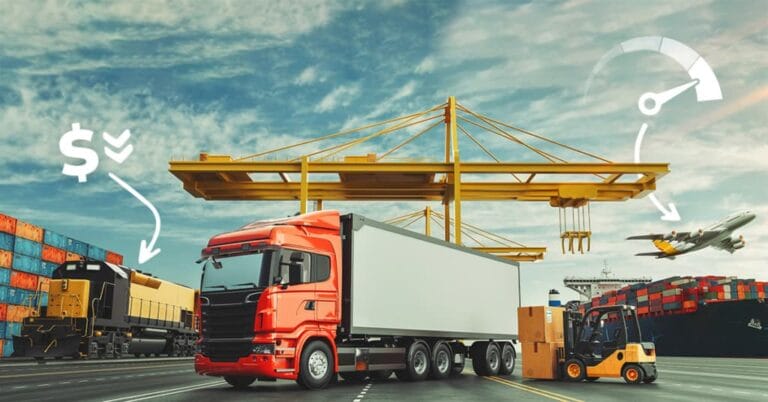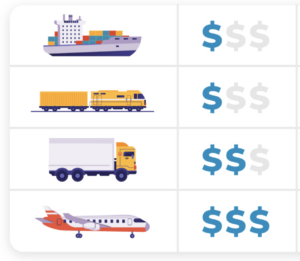The cost of shipping goods is an ongoing challenge for business owners. With supply chain complexities and pricing often subject to change, there’s a need for transparency in the freight shipping process.
The process of determining freight rates is intricate by design. It’s not just about weight or the amount of physical space that a shipment occupies, but a combination of factors that can vary significantly from one shipment to another.
This complexity is further compounded by the changing nature of things like fuel surcharges and the ever-evolving regulations in the logistics sector.
So, how can businesses make sense of it all? What role does technology play? Let’s demystify the factors that influence freight costs so you can have a more informed shipping strategy and budget.
Contents:
Factors influencing freight costs
Calculating freight cost in 5 steps
Factors influencing freight costs
Weight and volume
One of the primary determinants of freight cost is the weight and volume of the shipment. The choice between charging based on weight or volume depends on which is greater. Heavier or bulkier items typically incur higher charges due to their space and weight demands on transport vehicles (more on this in the next section).
Distance
The distance between the pick-up and delivery points is an essential factor to consider. Longer distances generally result in higher costs due to the increased fuel consumption and time required for transportation.
Mode of transport
The mode of transport chosen for freight shipping also has a bearing on overall cost. Different vehicles offer varying benefits in terms of speed, capacity, and cost. Aligning them with your specific needs is the key to identify the most efficient rate for your shipment.
The most common modes of freight transport include:
- Sea Freight. Ideal for extremely heavy or bulky items, sea freight is the most cost-effective option for international shipping. However, it’s slower and subject to weather disruptions.
- Rail Freight. Rail is an excellent option for transporting large volumes over long distances. It’s more environmentally friendly and usually more economical than road transport for bulk shipments.
- Road Freight. Often the most accessible and flexible option, road freight is preferred for short to medium distances. It allows for door-to-door delivery and is relatively cost-effective for smaller shipments.
- Air Freight. The fastest but most expensive mode, air freight is ideal for time-sensitive or high-value goods. Due to higher fuel costs and limited space, it’s typically used for smaller, lighter shipments.
Additional services
Additional services that can add extra costs to your shipping include:
- Insurance. Protecting goods against loss or damage during transit.
- Packaging. Adequate packaging is crucial for the safety of goods and may vary depending on the fragility and type of items being shipped.
- Customs Clearance. Necessary for international shipping, involving regulatory and paperwork costs.
- Warehousing. Storage costs may be incurred if goods need to be stored at any point during transit.
- Special Handling Requirements. Additional costs for handling fragile, hazardous, or oversized items that require special attention.
Freight cost components
Base rates
The base rate is the foundational cost of shipping freight, determined by carriers based on factors like distance, transport mode, and type of goods. An easy way to comprehend base rates is to think of them like a taxi’s ‘flag fall’ – the minimum charge that applies as soon as a shipment is picked up. This charge ensures that carriers cover basic transportation costs regardless of the shipment’s size or distance.
Minimum rates
Minimum rates act as a safety net for carriers, ensuring they’re compensated even for smaller, less profitable shipments. These rates are akin to a fixed minimum charge, applied when the total freight cost (calculated based on weight and volume) falls below a certain threshold.
Fuel surcharges
Fuel surcharges are added to cover the fluctuating costs of fuel. This dynamic component varies with changes in fuel prices, reflecting the direct impact of energy costs on transportation.
Additional surcharges
These include various specific fees that may apply based on the unique requirements of the shipment. Common additional surcharges are:
- Tail Gate Fees. Applied when special equipment like a tail lift is needed for loading/unloading in the absence of a loading dock. This surcharge reflects the additional time and effort required for handling specific types of cargo.
- Residential Pick-up and Delivery Fees. Charged for the extra effort needed to navigate residential areas, which are typically more challenging for large freight vehicles. For example, carriers may apply fees to compensate for the extra time and resources required for home deliveries.
- Overlength Charges. Imposed for cargo that exceeds standard size limits, needing special handling. This is because transporting larger or unusually shaped items requires more resources.
Taxes
Applicable taxes, such as the Goods and Services Tax (GST) in Australia, are added to the overall freight charges. These taxes contribute significantly to the final cost and are mandated by law.
Volume vs. dead weight
This component addresses whether charges are based on the shipment’s volume (the space it occupies) or its dead weight (actual weight). Carriers will choose the greater of the two as the basis for the cost, ensuring fair pricing based on the shipment’s physical characteristics.
Typically, volume is applicable when transporting lightweight, bulky items, while dead weight is considered for denser, heavier shipments.
To give you a clearer picture of how these costs are typically distributed in a freight shipment, here’s a pie chart illustrating the estimated percentages of each component:
Proportional Breakdown of Freight Cost Components
Calculating freight cost in 5 steps
Calculating freight costs can be streamlined by breaking it down into the following steps.
1. Gather required information
Collect all necessary details about your shipment, including weight, dimensions, destination, and the nature of goods. For instance, when shipping a batch of electronics, record their total weight, dimensions of the packaging, and the delivery address.
2. Determine freight class
Freight class is influenced by density, storability, handling, and liability. Each class is associated with a specific rate. Accurate classification is crucial as it impacts cost, especially for items that are fragile or irregularly shaped.
3. Obtain freight rate quotes
Use platforms that compare rates across different carriers. These tools can simplify the complex process of sifting through various carrier rates, which often resemble convoluted spreadsheets.
MachShip simplifies this step by providing a comprehensive comparison, helping you choose the most cost-effective option. For example, entering your shipment details into MachShip will generate a range of carrier options with different pricing, transit times, and service levels.
4. Calculate total freight cost
Add up the base rate, any surcharges, and applicable taxes, and consider additional costs such as insurance or special handling fees. Be aware of the details typically present in carrier rate cards.
These cards provide a granular breakdown of pricing, covering various routes, weights, and cargo types. They normally include a basic charge, a minimum rate, and variable costs that adjust per unit of weight for different distance brackets.
For example, a rate card might show that shipping a standard pallet from Sydney to Melbourne incurs a basic charge of $50, a fuel surcharge of $10, and an additional $0.20 per kilogram for weight over 200kg. If your shipment weighs 250kg, the total cost would be the basic charge, plus the fuel surcharge, plus the additional cost for the extra weight, resulting in a final cost calculation of $60 (basic + fuel) + $10 (extra weight) = $70.
5. Identify cost-saving opportunities
Look for ways to reduce costs without compromising on delivery quality. This might involve repackaging goods for more efficient use of space, choosing a different mode of transport, or consolidating shipments. Understanding the impact of volume versus dead weight is key here. For example, changing packaging to reduce volume could lower costs if the volume-based rate is higher than the weight-based rate.
MachShip’s delivery management software offers actionable insights for businesses looking to optimise their shipping processes. This includes suggestions on packaging efficiency or the strategic selection of transport hubs based on historical data analysis.
MachShip’s predictive analytics leverage historical data also to forecast future trends and potential cost-saving opportunities. This AI-driven approach allows businesses to not only understand their current shipping costs but also to strategically plan for efficiency in the long term.
Summary
Regardless of the fixed costs involved in freight shipping, having a detailed understanding of the process enables you to optimise costs in your favour. Technology plays an essential role in this. Platforms like MachShip not only ease the burden of dealing with intricate rate cards and variable pricing models, but also transform the daunting task of freight calculation into a strategic opportunity. Not to mention the time it saves in running the numbers.
MachShip’s goal is to break down the noise and confusion into clear, transparent components, enabling users to make informed decisions about their shipping needs.
Discover how you can analyse historical data and access real-time insights to make informed shipping decisions with MachShip.
To see how MachShip can help your business grow, book a free demo today.
FAQs
Q. How can you save on freight costs?
A. Optimise packaging, consolidate shipments, choose cost-effective transport modes, negotiate with carriers, and leverage technology for rate comparisons.
Q. What are sea freight rates?
A. A sea freight rate is the charge for transporting goods via cargo ship, calculated based on container size, weight, distance, and additional services.
Q. What’s the formula for freight cost?
A. Freight cost is often calculated as: (Base Rate + Fuel Surcharge + Other Surcharges) x (Weight or Volume) + Additional Services.
Q. How do you measure freight cost?
A. Freight cost is measured by combining the base shipping rate with surcharges, taxes, and additional service fees, considering the shipment’s weight, volume, and distance.
Q. How much is freight per km in Australia?
A. Freight cost per kilometre varies based on factors like transport mode, fuel costs, and vehicle type. It’s best to consult specific carriers or use rate calculators for accurate rates.
For more detailed answers to your shipping management questions, visit this page.


